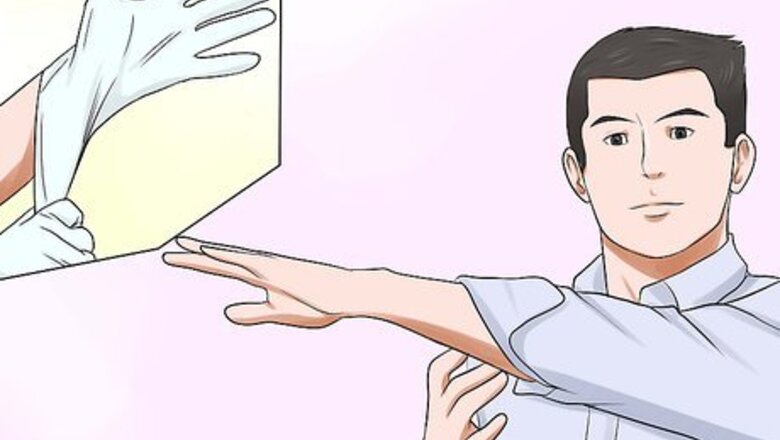
views
Getting Your Rabbit Used to You
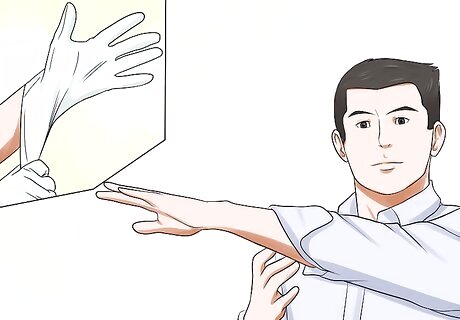
Be prepared. If you have a particularly vicious rabbit, you may need to take precautions at first. You might need to wear clothing or gloves to protect yourself from biting when you interact with the rabbit. You should be able to tell if you need to take this precaution. For instance, if every time you go near the rabbit, it tries to bite you, that's a good indication you need to protect yourself.
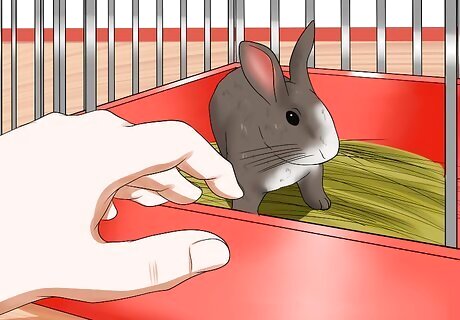
Greet it in its cage. Start by spending time with it near or in its cage, if it's big enough. Open the door, and sit near the opening if it's not big enough for you to get in. Let the bunny come up and sniff you. Letting it take its time will give it a chance to get to know you. You may even consider laying down, if the bunny is merely shy. If you loom above the bunny, it will likely see you as a predator. However, you may not want to lay down if the bunny keeps lunging at you and trying to bite.
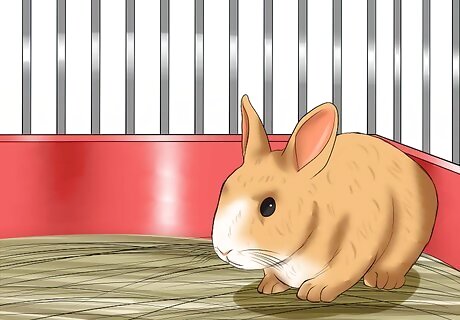
Watch for visual cues. Sometimes, you need to follow the lead of the rabbit. Rabbits are like cats in that it's best to wait until the animal asks for attention. One way a rabbit may ask for attention is to lean against the side of the cage. If you notice this behavior, you can try to stroke the rabbit's head through the bars with your fingers, talking softly and sweetly to it as you approach.
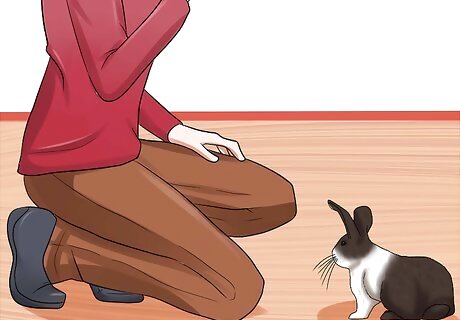
Let it out around you. In a rabbit-proof room, let the rabbit out. Sit on the floor at the rabbit's level. Give it a chance to get curious about you. As the rabbit approaches you and sniffs, give the rabbit a treat. Every time the rabbit comes back to you, give it another treat. That way, the rabbit comes to associate you with good food. You only want to use treats the first couple of times. After that, switch to pellets you take out of its daily quantities. You can also use veggies the rabbit likes. The rabbit should be eating leafy greens, so that's a good place to start, such as parsley, green or red leaf lettuce, beet greens (red Swiss chard), bok choy, mustard greens, or collard greens. You can also use small amounts of fruit, such as strawberries, pears, or oranges (no peels on the oranges). To rabbit-proof a room, all cords need to be hidden (such as in plastic tubing) or out of reach. You also need to remove any plants that are toxic to bunnies, which you can look up on sites like this one: http://rabbit.org/poisonous-plants/. For instance, some toxic plants include daffodils, irises, tomato leaves, and mistletoe. You may also need to block off areas the rabbit may want to chew, such as blocking baseboards with a board. You can also use a small, movable pet fence to create a safe area.
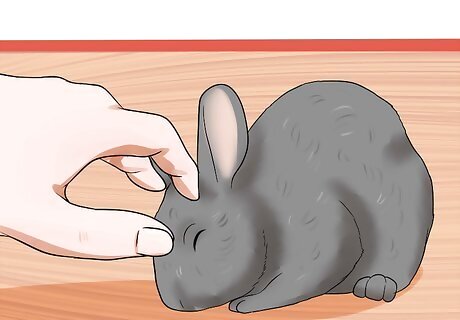
Pet from above. Once your rabbit gets to know you, try petting it when it approaches. The best way to do this is to place your hand above the back, not above or in front of the head. If your hand is in front of the rabbit, it has a chance to leap forward and bite you. Avoid hovering your hand over the rabbit's head in a predator-like way. Hovering over the head may cause the rabbit to become fearful and/or stressed.
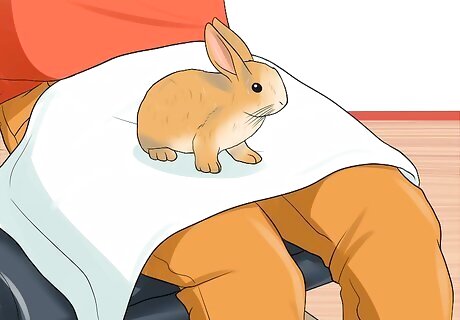
Spend time each day with your rabbit. You can't tame your rabbit in a day. You also can't visit with your rabbit once a week and expect it to get tame. You must spend time each day petting your rabbit and letting it get to know you. In fact, you can increase the time you spend with it a little each day.
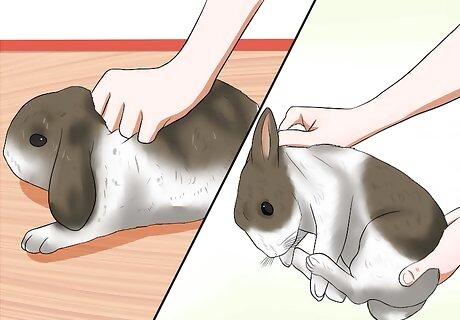
Try picking it up. Once your rabbit is accustomed to you, trying picking it up. When picking it up, use a hand underneath the chest between the legs. Use the other hand to support its back end. Don't try to lift it by the back of the neck (the scruff), the legs, or the ears. You could seriously hurt your rabbit. Your rabbit is likely to be scared by this approach because it is similar to being caught by a predator. Remember, some rabbits may never like being picked up, though of course it is necessary from time to time. You can use this hold for moving the rabbit short distances. For longer distances, hold the bunny, stomach down, against your chest. Have one hand under its rump and one hand across its shoulders. Loop your thumb over a front leg to keep it from jumping over your shoulder and hurting itself.
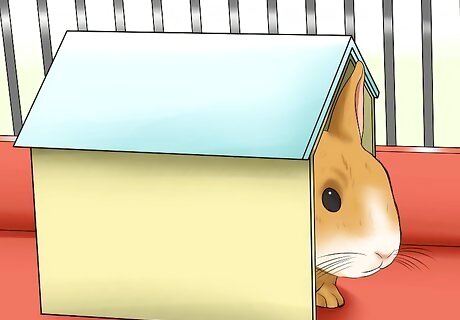
Remove the house for an hour or two. One way to encourage socialization is to remove the rabbit's smaller house from the cage. A shy rabbit will spend much of its time inside the house, so removing it forces it to come out and socialize with you. Remember, though, the house is where the rabbit feels safe, so be sure to put it back.
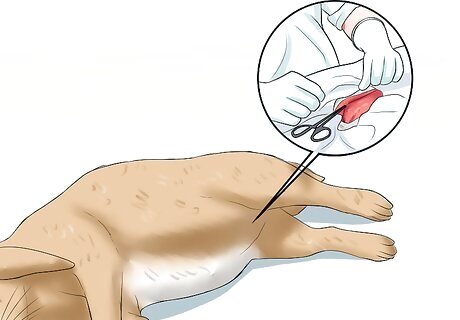
Get the rabbit spayed or neutered. Getting the rabbit spayed or neutered is an important part of taming a rabbit. Rabbits that are not spayed or neutered have hormones running through their body, which in turn can make them more aggressive. Take the rabbit to a vet that works with rabbits and other exotic pets. For instance, a rabbit that circles you and tries to nip is saying she's wanting sex. By spaying her, you can cut down on this behavior. However, remember that this step will take time to take effect. Expect a month's wait after the rabbit is spayed or neutered for this step to really help.
Using Cues to Help You and Your Rabbit
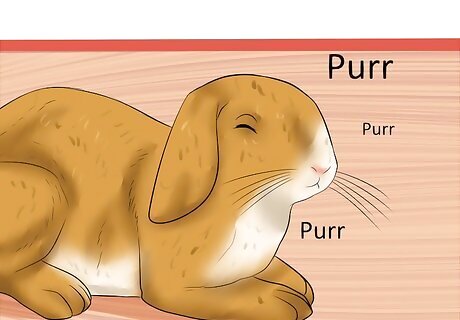
Listen for purring. Just like a cat, a rabbit will purr when happy. This sound helps you understand when the rabbit is happy, so you can repeat behaviors the rabbit likes. Unlike a cat, a rabbit's purr is made with its teeth, so listen for the sound coming from the mouth.
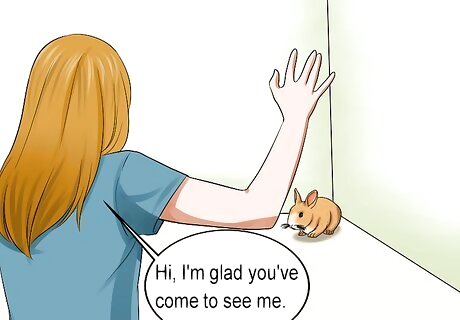
Reward aggression with calmness. Striking back with aggression or even an angry tone when a rabbit is aggressive only makes it more aggressive. Instead, treat every advance with a happy tone, such as, "Hi, I'm glad you've come to see me." You can still move your limbs out of the way, but with calmness and deliberateness.
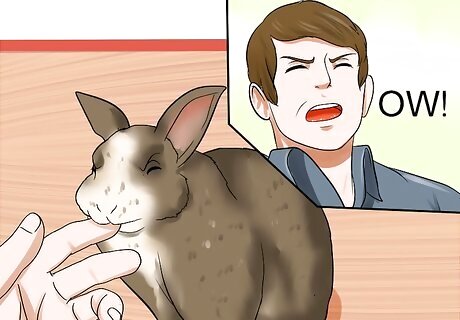
Make a sound when the rabbit bites. While you need to stay calm, you can help your rabbit learn that biting hurts. If your rabbit nips, it's okay to make a sound like "Ow!" or even a high-pitched "EEK!" That cues the rabbit in to the fact that it's hurting you. In turn, you're encouraging the rabbit to stop the behavior, partially because you're startling it.
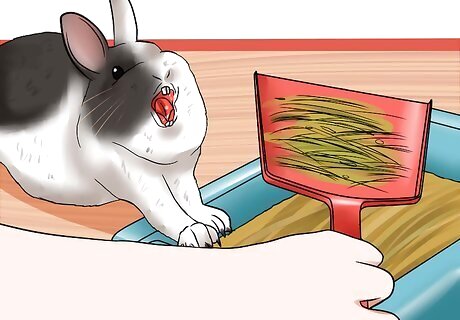
Watch for triggers. Every rabbit is going to have things it doesn't like. For instance, your rabbit may not like to see you mess with its litterbox. Alternatively, your rabbit may not like its paws touched. Another thing your rabbit may not like is having someone in its cage. Once you figure out what upsets your rabbit, you can take steps to minimize those triggers.
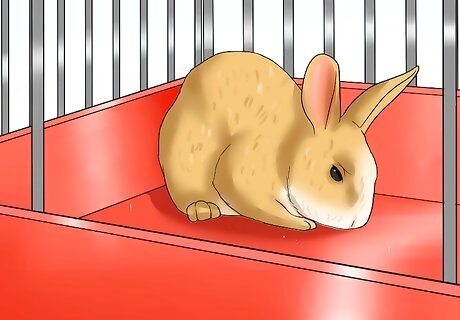
Entice, don't force. Sometimes, your rabbit will let you know it doesn't want to come out of its cage by moving to the back. If you need the rabbit to come out of the cage, don't drag it out. Rather, open the cage and let it hop out in its own time. If it doesn't want to come out, consider offering a treat outside the cage. You can even put a treat in a carrier so the rabbit has something to hop into.
Trying Clicker Training
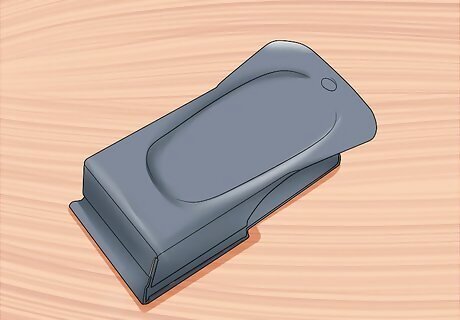
Use a clicker to train tame behaviors. Clicker training is when you use positive reinforcement to encourage good behaviors. The clicker is a small device that makes a clicking noise. You can find them at many pet stores, and they are often used in dog training. You reward good behaviors and click at the same time, so the rabbit comes to associate the clicking sound with happy things. You can also use a simple clicking pen for this sound. Associate the clicker with good things. Give the rabbit food, and as the rabbit takes a bite, make the clicking noise. If it startles the rabbit, you can muffle it a bit. You can also sound the clicker first, then give the bunny a small treat. Repeat several times, training in small bits each day to get your bunny used to the clicker sound. You can test to see if your bunny understands by making the noise when the bunny is doing something else. If it turns towards you, looking for food, the rabbit understands.
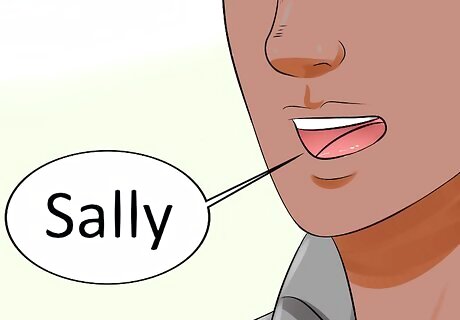
Decide on desired behaviors. For instance, maybe you want the rabbit to come when you call it. Once you have the rabbit coming to the clicker, you can start working on its name. As you make the clicking sound, also call the rabbit's name. Reward the rabbit with food as it comes towards you. Practice this step every day. After a few days, take out the clicking step to try just calling the rabbit's name. The reason you start with clicking is it is a short, identifiable sound that's easy for the bunny to understand. Moving to the name will take a little time.
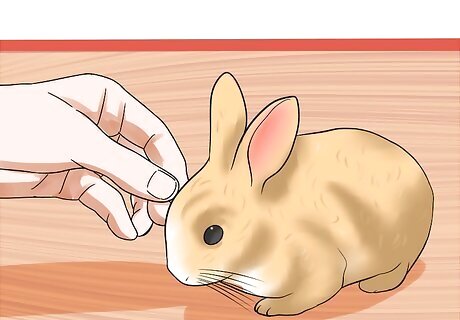
Move towards touching. Once you get the rabbit to come to you on cue, you can work on petting and touching. Start by training the rabbit to touch its nose to your hand. After that, work towards petting the rabbit, rewarding with clicking and treats. As the rabbit approaches you, hold out your hand. If your rabbit comes up to sniff or touch your hand, reward the rabbit with a click and a treat. Move your hand around to different places, and then hold still so the rabbit can approach. Every time the rabbit comes close to or touches your hand, immediately click and deliver a treat. When your rabbit seems confident, start gently moving your hand over its head as it touches you. As you press towards the rabbit, click and give a treat. That way, it associates you touching it with food. Once you pet its head with confidence, try touching other areas, such as its rump or paw. In fact, you can use head pets for a reward for touching other areas once your rabbit finds it enjoyable. If your rabbit seems upset by the petting, move back to just getting it to touch your hand until the rabbit seems happy and confident again.
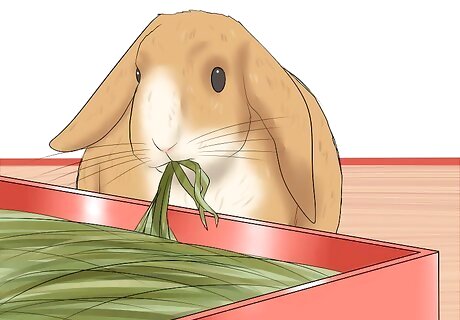
Work when the rabbit is hungry. One way to encourage the training to go faster is to wait until it's dinnertime. Then, use the training session to feed it part of its dinner. That way, the rabbit will be more motivated to come over to the food because it's hungry.




















Comments
0 comment